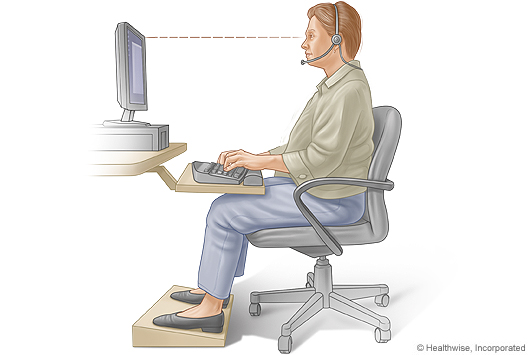Breadcrumb
- Home
- Proper Sitting Posture For Typing
Proper Sitting Posture for Typing

Good sitting posture at your workstation means your shoulders are relaxed, your feet are flat on the floor, and you can sit up straight to do your work. Guidelines include:
- A chair that helps you keep your normal spinal curvature. A supportive chair:
- Is adjustable, so that you can set the height to rest your feet flat on the floor. Keep your feet supported on the floor or on a footrest to reduce pressure on your lower back. Some people like to sit in a slightly reclined position because it puts less stress on the back, although this may increase stress on the shoulders and neck when reaching for items.
- Supports your lower back.
- Has adjustable armrests that allow your elbows to stay close to your sides. If you are not comfortable with armrests, move them out of your way. It is still important to keep your arms close to your sides even if you choose not to use armrests.
- Has a breathable, padded seat.
- Rolls on five wheels for easy movement without tipping.
- A computer keyboard and keyboard tray that allow comfortable typing or keying.
- Your keyboard should be at a height that allows your elbows to be bent about 90 degrees and close to your sides.
- Many keyboards and keyboard trays have wrist supports to help keep your wrists in a neutral, almost straight position. But wrist pads are just there for brief rests. They are actually not meant to be used while you are typing. But some people find the pads helpful even when they are using their keyboard or mouse. When you type or use your mouse, try raising your forearms a little so your wrists are in a neutral position and your arms and hands can move freely. If you have arm rests on your chair, you may be able to adjust them so your forearms are parallel to the floor and your wrists are neutral. Your wrist is in a neutral position when the thumb is in line with the forearm and the wrist is bent slightly back, such as when your arm is hanging at your side. You may want to alternate between resting your wrists on the pads and raising them up. If you use a wrist pad, it's best to rest your palm or the heel of your hand on the support, rather than your wrist.
- The tilt of the keyboard can be adjusted. Some people find in more comfortable if the keyboard is flat or tilted slightly down at the top. Try different tilt angles to see what is most comfortable for you.
Current as of: November 14, 2022
Author: Healthwise Staff
Medical Review:
Adam Husney MD - Family Medicine
Kathleen Romito MD - Family Medicine
Joan Rigg PT, OCS - Physical Therapy
Current as of: November 14, 2022
Author: Healthwise Staff
Medical Review:Adam Husney MD - Family Medicine & Kathleen Romito MD - Family Medicine & Joan Rigg PT, OCS - Physical Therapy
This information does not replace the advice of a doctor. Healthwise, Incorporated disclaims any warranty or liability for your use of this information. Your use of this information means that you agree to the Terms of Use and Privacy Policy. Learn how we develop our content.
Healthwise, Healthwise for every health decision, and the Healthwise logo are trademarks of Healthwise, Incorporated.

